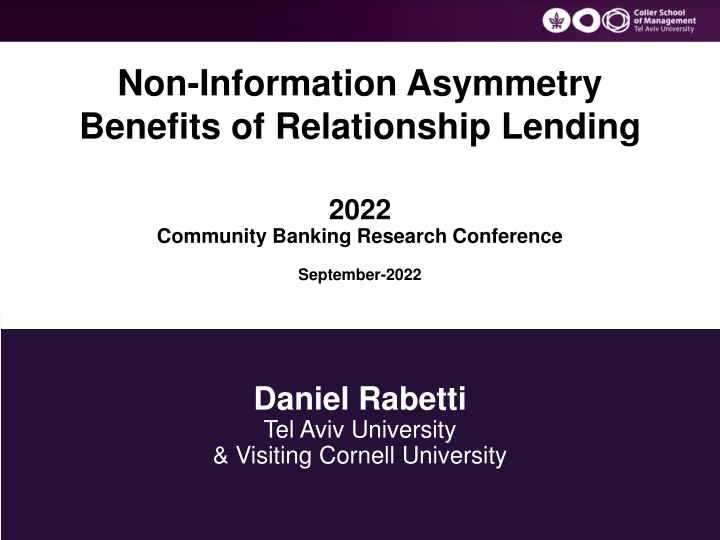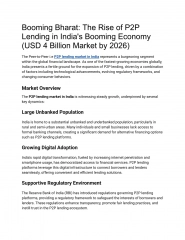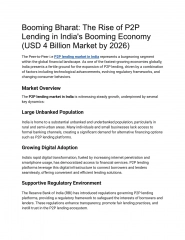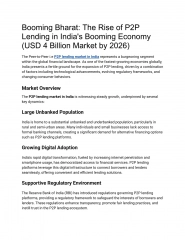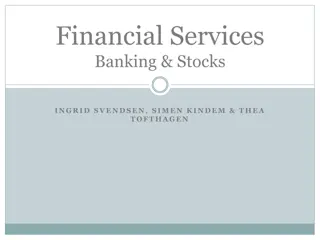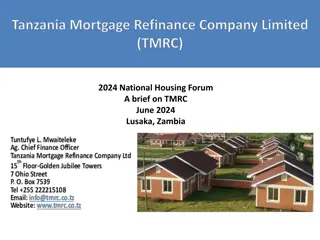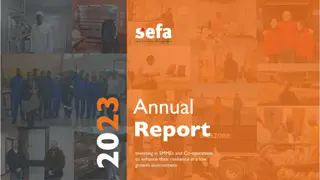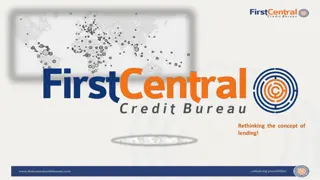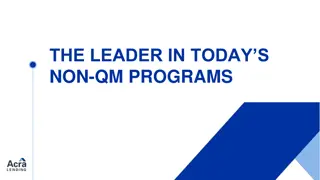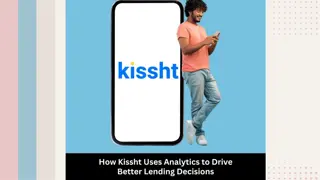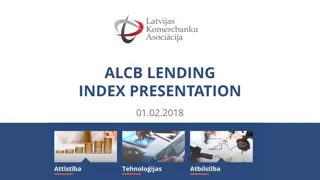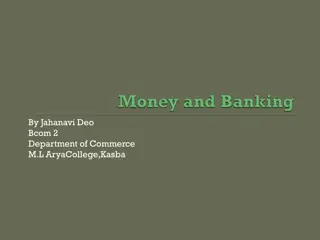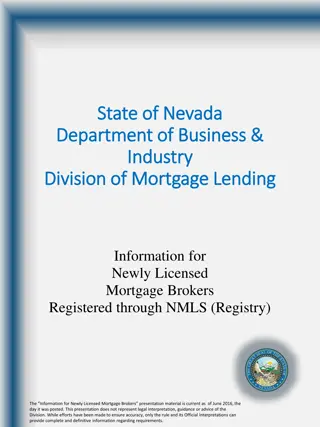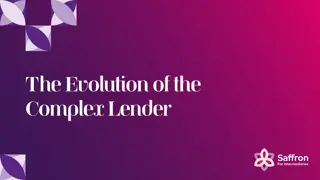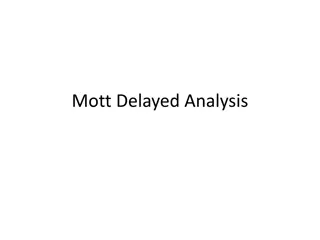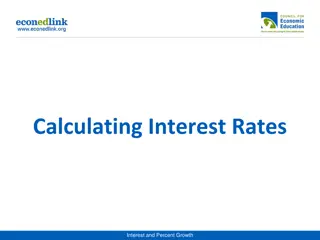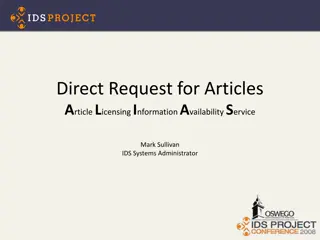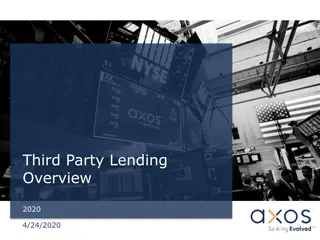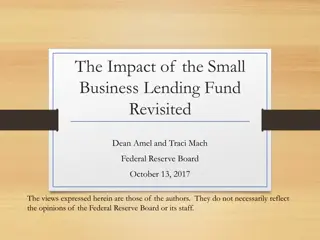Non-Information Asymmetry Benefits of Relationship Lending
Relationship lending in the community banking sector offers advantages in lowering spreads, increasing loan sizes, reducing collateral requirements, and relaxing covenants especially for less transparent firms. A study by Daniel Rabetti explores how relationship lending addresses issues related to asymmetric information in loans.
Download Presentation

Please find below an Image/Link to download the presentation.
The content on the website is provided AS IS for your information and personal use only. It may not be sold, licensed, or shared on other websites without obtaining consent from the author.If you encounter any issues during the download, it is possible that the publisher has removed the file from their server.
You are allowed to download the files provided on this website for personal or commercial use, subject to the condition that they are used lawfully. All files are the property of their respective owners.
The content on the website is provided AS IS for your information and personal use only. It may not be sold, licensed, or shared on other websites without obtaining consent from the author.
E N D
Presentation Transcript
Non-Information Asymmetry Benefits of Relationship Lending 2022 Community Banking Research Conference September-2022 Daniel Rabetti Tel Aviv University & Visiting Cornell University
Motivation: asymmetric information What we know about relationship lending - Solve problems of asymmetric information: - monitoring (Diamond (1984); - screening (Ramakrishnan and Thakor (1984)); - adverse selection (lending to low-quality borrowers); - moral hazard (borrowers' incentives to invest sub-optimally) - Benefits for borrowers and lenders: - relationship lending is associated with lower spreads, larger loans, lower collateral requirements, and relaxed covenants in particular for less transparent firms (Pertesen and Rajan (1994), Cole (1998), Cayseele and Degryse (2000), Bharath et al (2011) and Prilmeier (2017). Daniel Rabetti Community Banking Conference
Motivation: Non-Information Asymmetry (Open question!) What we don t know about relationship lending - Do banks favor relationship borrowers when there is no information asymmetry in the loan? If so, then: - what are the benefits associated with it? - what are the costs associated with it? - why do banks favor relationship borrowers? Daniel Rabetti Community Banking Conference
The setting: a great laboratory The Paycheck Protection Program (PPP) setting provides unique opportunity to test these questions: - By construction: No asymmetric information in the loan structure: - Loans are backed by the Federal Reserve; - No restriction to borrowers' credit risk; - Loan based on and limited to borrowers payroll size; - Fixed interest rate and loan term structure; - No colaterals or covenants. - As consequence: - Information channel plays little role; - Competition from less informative lenders; - Opportunity to attract new customers. Daniel Rabetti Community Banking Conference
Data: public firms Manually collected from 8K and 10K disclosures: - About 1,000 firms' disclosures: - a textual analysis algorithm extracts the loan amount, loan request, and disbursement date, and lender's name; Daniel Rabetti Community Banking Conference
Data: public firms Mannually collected from 8K and 10K disclosures: - About 1,000 firms' disclosures: - a textual analysis algorithm extracts the loan amount, loan request and disbursment date, and lender's name; - check lender's name on SEC fillings; - variation on relationship: (i) any (e.g., deposit or scrow account); (ii) lending, and (iii) transaction relationship. - JP Morgan: 51% (35%) any (lending) relationship. Daniel Rabetti Community Banking Conference
Data: public firms Manually collected from 8K and 10K disclosures: - About 1,000 firms' disclosures: - a textual analysis algorithm extracts the loan amount, loan request, and disbursement date, and lender's name; - check lender's name on SEC fillings; - variation on relationship: (i) any (e.g., deposit or scrow account); (ii) lending, and (iii) transaction relationship. - JP Morgan: 51% (35%) any (lending) relationship. Daniel Rabetti Community Banking Conference
Data: private firms The Small Business Administration (SBA) data: - Full data released in August 2020, covering the entire population of lenders and borrowers. - for PPP above 150K: >700K firms and >4K lenders; - key information about the firm and loan characteristics, such as loan size range, firm and lender name, state, NAIC code, and reported number of employees; - match SBA firms to DealScan dataset: - scope: limited information on firms; - missing data: loan request date and repayments; - selection issues: a small portion of matched firms; Daniel Rabetti Community Banking Conference
Distribution of funds Daniel Rabetti Community Banking Conference
Summary statistics Daniel Rabetti Community Banking Conference
Research design To examine the effects of relationship lending, the following model is constructed: is one of the four response variables: (i) Size: the logarithm of loan size in dollars; (ii) Velocity: the distance in days between the loan request and loan received to date; (iii) Non-Complier: an indicator that switches on when the borrower has more than 500 employees; (iv) Payback: an indicator that switches on when the borrower returns the PPP loan in full; Daniel Rabetti Community Banking Conference
Research design To examine the effects of relationship lending, the following model is constructed: is the relationship indicator and can be: (i) any relationship or transaction borrower (ii) lending relationship or transaction borrower. Daniel Rabetti Community Banking Conference
Research design To examine the effects of relationship lending, the following model is constructed: is the industry fixed effect; is the state fixed effect; is the bank fixed effect; is a vector of lender's controls; is a vector of borrower's controls; Daniel Rabetti Community Banking Conference
(I) Do banks favor relationship borrowers when there is no information asymetry? Daniel Rabetti Community Banking Conference
(I) Are there relationship lending benefits in the paycheck protection program? Daniel Rabetti Community Banking Conference
Benefits A: Loan Size ~ REL +... Daniel Rabetti Community Banking Conference
Benefits B: Velocity ~ REL +... Daniel Rabetti Community Banking Conference
Validity and robustness tests Daniel Rabetti Community Banking Conference
External Validity: Private firms Daniel Rabetti Community Banking Conference
Alternative Specifications Daniel Rabetti Community Banking Conference
(I) Do banks favor relationship borrowers when there is no information asymetry in the loan? Yes, relationship borrowers receive larger loans and faster approvals. Daniel Rabetti Community Banking Conference
(II) Why do banks favor relationship borrowers? Tension: absence of information advantage Daniel Rabetti Community Banking Conference
Proposed motivations: Either for future business opportunities (Bolton(2016) or to mitigate borrower's default risk (evergreening) Daniel Rabetti Community Banking Conference
(1) Deposits vs Lending accounts Daniel Rabetti Community Banking Conference
(2.1) Pre-crisis characteristics: Peers Daniel Rabetti Community Banking Conference
(2.2) Pre-crisis characteristics: Industry Daniel Rabetti Community Banking Conference
(3.1) Portfolio's default risk evolution Daniel Rabetti Community Banking Conference
(3.2) Portfolio's default risk evolution Daniel Rabetti Community Banking Conference
(II) Why do banks favor relationship borrowers when there is no information asymetry in the loan? To mitigate borrowers' default risk at the lender's portfolio Evergreening motivation! Daniel Rabetti Community Banking Conference
(III) Are there relationship lending costs when there is no information asymmetry in the loan? Daniel Rabetti Community Banking Conference
Costs A: Non-Compliance ~ REL +... Daniel Rabetti Community Banking Conference
Costs B: Payback ~ REL +... Daniel Rabetti Community Banking Conference
Conclusion What have we learned about relationship lending effects when information asymmetry in the loan plays a minor role? - Lenders favor relationship borrowers: - Benefits: larger loans and faster approvals; - Why: to mitigate default risk associated with borrowers pre- crisis debt (evergreening mechanism); - Costs: relationship borrowers are more like to violate the program rules and to return loans earlier; - Implications: relationship lending effects are relevant in times of crisis. However, evergreening lending is an issue: (a) non-relationship borrowers move down the waiting line; (b) transfers pre-crisis loan risks to the FED balance sheet. Daniel Rabetti Community Banking Conference
Thank You! Daniel Rabetti Coller School of Management Tel Aviv University Contact: rabetti@mail.tau.ac.il Daniel Rabetti Community Banking Conference
